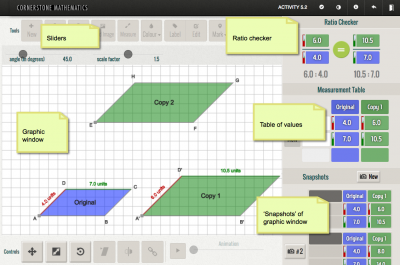
The geometric similarity curriculum unit uses the context of designing images for mobile devices with different screen sizes to develop pupils' understanding of the variant and invariant properties of geometrically similar polygons. i.e. what changes and what stays the same.
It introduces the following 'hard to teach' mathematical ideas:
- Identifying the variants and invariants in shapes that are mathematically similar, including identification of the scale factor of enlargements.
- Recognising the important one-to-one geometric correspondence of sides and vertices within mathematically similar polygons.
The software has been designed to offer:
- dynamic measurements and comparisons, driven by angle and scale factor sliders.
- support for structuring recording within tables.
- linking between geometrical manipulation and values in tables and the ratio checker.
Downloads
- Resources for school based PD
The following resources are provided to support schools to involve more teachers in the department to teach the Cornerstone Maths geometric similarity unit with confidence.
- A 3 minute introductory video about the geometric similarity unit
- A presentation to support a PD session to introduce teachers to the key mathematical ideas addressed by the unit and to gain hands-on experience with the software (PowerPoint)
Downloads
The complete set of PD resources (zip file)
- Landmark activity - (Investigation 5) More than just lengths of sides
Landmark activities are those in which the use of the technology prompts pupils (and teachers) to have an 'aha' moment about the mathematics.
In the geometric similarity, the landmark activity challenges pupils' early definitions of geometric similarity that rely on properties of the side lengths. However, pupils will often need some careful support to use the software productively - and have a personal 'aha' moment.
Watch the following video clips to see how different teachers have used the software to support this dialogue:
Example 1Example 2
Some examples of pupils' written work
and- Designing school-based assessments
The nature of the Cornerstone Maths activities results in some rich opportunities for accurate assessment of pupils' mathematical understanding.
The following Investigations (and particular questions) from the Geometric similarity unit are especially effective:- Investigation 2, Question 4-5 "What is the relationship between an original and a mathematically similar shape?"
- Investigation 3, Question 11-12 "Describe what a scale factor is. Describe how to use it..."
- Investigation 4, Question 7 "Devise a set of instructions so that anyone can create mathematically similar enlargements."
- Investigation 5, Question 2 "What is the relationship between corresponding angles in mathematically similar shapes?"
Some students' responses to these questions for a departmental discussion about assessment (
or ).
 Close
Close


